|

Writers, Poets and Sculptors
on Isadora and the Dance
Photo essay by Dahna Barnett
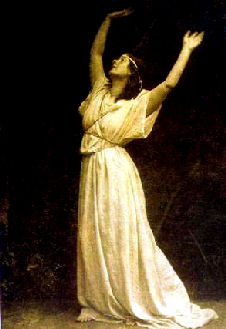
"The wind? I am the wind. The sea and the moon? I am the sea and the moon. Tears, pain, love, bird-flights?
I am all of them. I dance what I am. Sin, prayer, flight, the light that never was on land or sea? I dance what I am."
— Carl Sandburg: "Isadora Duncan"
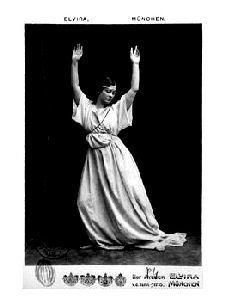
Isadora Duncan 1903-04 Elvira Studio
"Oh body swayed to music, oh brightening glance
How can we know the dancer from the dance?"
— William Butler Yeats
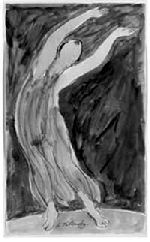
Isadora Duncan by Abraham Walkowitz
Mount Holyoke College Art Museum
"Her dances were hymns to freedom—of sensibility, of passion, of the transcendentally convinced
and convincing Emersonian soul... . Today it is hard to picture convincing interpretations of Joy, Hope, Immortality, the Soul.
But at the turn of the century an American girl, incarnating these and more, coincided with historical promise." — Lincoln Kirstein
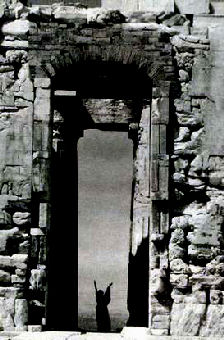
At the Parthenon, 1920 by Edward Steichen
"What glorious things she makes the soul remember! Once we were young, and the leaping blades of our desire striking the granite
facts of life lit lively fires of wonder. We were simple, so that when the moving beauty of nature and the joy of each other's company
stirred us to ecstasies, we sought free and natural expression; we danced-we danced as the movements of waves and branches, and
as the exquisite beauties of our own bodies suggested. Such memories she evokes by her subtle gestures and movements. The
morning of time dawns on our spirits again, and once more we have a sense that hears the gods." — Shaemas O'Sheel
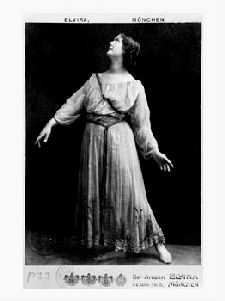
Isadora Duncan 1903-04 Elvira Studio
"Come away!" her dancing says. "Come out into the splendid perilous world! Come up on the mountain-top where the great wind blows!
Learn to be young always! Learn to be incessantly renewed! Learn to live in the intemperate careless land of song and rhythm and rapture!
Say farewell to the world you know and join the passionate spirits of the world's history! Storm through into your dreams! Give yourself up
to the frenzy that is in the heart of life, and never look back, and never regret!" — Robert Edmond Jones
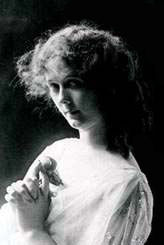
Isadora 1898 by Jacob Schloss
"In those moments where beauty and emotion fuse and climax, something of the immortal floats about the dancer;
she wanders in a divine ray, in a mist where all works of art circle in unison with her." — Reynaldo Hahn
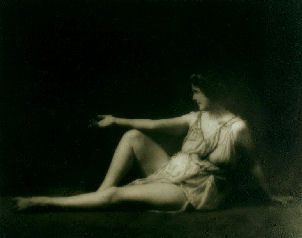
"The attitude of great poets is to cheer up slaves and horrify despots. The turn of their necks, the sound of their feet,
the motions of their wrists, are full of hazard to the one and hope to the other." — Walt Whitman

"Isadora in Revolt" by John Sloan
Fort Lauderdale Museum of Art
"Isadora Duncan! ...It's positively splendid! I feel that she dances a symbol of human, animal happiness as it should be,
free from the unnatural trammels. Her great big thighs, her small head, her full solid loins, belly—clean, all clean—she dances
away civilization's tainted brain vapors, wholly human and holy—part of God." — John Sloan

"Isadora Duncan the Free Dance"
by Valentin
Biennale Iternationale dell' Arte Contemporanea Award
Florence, Italy
"When she read my first book Visions and Revisions, she sent me so many red roses that they filled the little flat, but I was too nervous to go and see her. She has been one of the most thrilling sensations-but that is a wretched word to express it-of my whole existence. She has danced for me alone-with a beauty that makes the most beautiful young girls' dancing seem mere child's play. It was as though Demeter herself, the mater dolorosa of the ancient earth, rose and danced. Well, she has gone-and I enclose to you the red rose she gave to me as she went." — Auguste Rodin from a letter to his brother Llewelyn, November 18, 1917
Learn more about Isadora Duncan at the
Isadora Duncan Dance Foundation website
Return to the Mythic Passages Menu
Subscribe to the Mythic Passages e-zine
|

